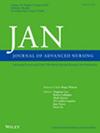摘要
目的:在COVID-19大流行期间,确定产后抑郁症(PPD)的比例,探索与PPD相关的风险因素,并研究青少年和成年母亲在产后6个月内PPD、社会支持和生活质量(QOL)的变化:设计:在 2021 年 1 月至 8 月期间使用在线问卷进行纵向比较研究:研究招募了 65 名青少年母亲和 65 名成年母亲,她们在产后 6 周到泰国大城府、差春骚府和北武里府的基层医院进行产后检查。在产后 6 周、4 个月和 6 个月时,通过爱丁堡产后抑郁量表、产后支持问卷和世界卫生组织生活质量简报收集数据:最后,60 名青少年母亲和 60 名成年母亲被纳入分析范围。在产后 6 个月期间,与成年母亲相比,青少年母亲的社会支持和生活质量均较低。值得注意的是,从产后6周到产后6个月,青少年母亲和成年母亲的PPD比例都明显增加(分别为31.7%-48.3%和23.3%-43.3%)。然而,各组之间的 PPD 比例并无明显差异。在调整模型中,产后前6个月PPD的重要风险因素包括受教育程度、意外怀孕、分娩方式和社会支持:青少年母亲和成年母亲在产后 6 个月内的 PPD、社会支持和 QOL 都发生了显著变化。与成年母亲相比,青少年母亲在产后 6 周、4 个月和 6 个月的社会支持和 QOL 水平一直较低。此外,教育程度较低、意外怀孕、剖腹产和社会支持较少的母亲更容易出现 PPD:启示:助产士/护士应在产后六个月内为所有母亲提供常规 PPD 筛查,尤其是高危母亲,如青少年母亲或教育程度较低、意外怀孕、剖腹产和社会支持有限的母亲:我们遵循了 STROBE 指南:无患者或公众贡献。Aims: To determine the proportion of postpartum depression (PPD), explore associated risk factors with PPD, and examine changes in PPD, social support and quality of life (QOL) among adolescent and adult mothers in the first 6 months postpartum during the COVID-19 pandemic.
Design: A longitudinal comparative study was conducted using an online questionnaire from January to August 2021.
Methods: The study recruited 65 adolescent and 65 adult mothers who attended postpartum checkups at 6 weeks postpartum in primary hospitals across Ayutthaya, Chachoengsao and Phetchaburi provinces in Thailand. Data were collected by the Edinburgh Postnatal Depression Scale, Postpartum Support Questionnaire, and the World Health Organisation Quality of Life Brief at 6 weeks, 4 months and 6 months postpartum.
Results: Finally, 60 adolescent and 60 adult mothers were included for analysis. Adolescent mothers experienced lower social support and QOL compared to adult mothers over the 6-month postpartum period. Notably, both adolescent and adult mothers had significantly increased PPD proportions from 6 weeks to 6 months postpartum (31.7%-48.3% and 23.3%-43.3%, respectively). However, there was no significant difference in the PPD proportions between groups. In adjusted models, significant risk factors for PPD during the first 6 months postpartum included educational level, unintended pregnancy, mode of delivery and social support.
Conclusion: Significant changes in PPD, social support and QOL were observed in both adolescent and adult mothers during the first 6 months postpartum. Adolescent mothers consistently demonstrated lower levels of social support and QOL at 6 weeks, 4 months and 6 months postpartum compared to adult mothers. Additionally, mothers with lower educational attainment, unintended pregnancies, caesarean deliveries and low social support were more likely to experience PPD.
Implications: Midwives/nurses should provide routine PPD screenings throughout the first six months postpartum for all mothers, particularly for at-risk mothers such as adolescent mothers or those with lower education, unintended pregnancies, caesarean deliveries and limited social support.
Reporting method: We have followed the STROBE guidelines.
Patient or public contribution: No patient or public contribution.

 求助内容:
求助内容: 应助结果提醒方式:
应助结果提醒方式:


